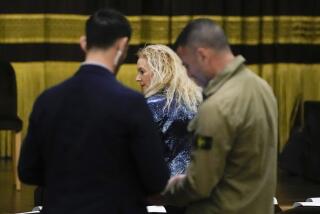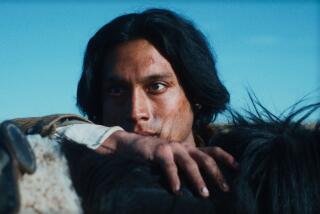Sicily Wants to Give the Boot to Its ‘Godfather’ Image
- Share via
PALERMO, Sicily — The Sicily of “Godfather” fame suggests a Mafia-ridden badlands where family feuds are settled in blood.
The Sicily of a new Saatchi & Saatchi advertising campaign portrays a Mediterranean paradise with spectacular beaches, 5th-century Greek temples and orange groves.
It’s tough to know where image and reality meet in Sicily, historically a place apart in map and mind from “il continente,” as Sicilians refer to the boot-shaped mainland of Italy.
The Italian government, though, is trying to bury the island’s less-than-sunny reputation as a mob haven by highlighting it as a tourist and business destination.
It has launched a new publicity campaign and given the go-ahead to a decades-old idea to build a bridge to the mainland that authorities say will bring visitors and investment to the island.
Construction of the two-mile rail-and-road bridge, the world’s longest, is to begin by 2005 and be completed by 2011, its $4.7-billion price tag split between the public and private sector.
And that’s precisely where Sicily’s Mafia reality may come into play.
There are fears that the bidding and building will be tainted by mobs that have long held sway over construction on the island.
On a profit this size, “the Mafia will make a tremendous amount of money,” said Gianfranco Pasquino, a former leftist senator and member of the government’s Anti-Mafia Commission in the 1980s and ‘90s.
“There’s no way the Italian state can control it,” he said. “They can find a decent entrepreneur, [but the Mafia] can blackmail him.”
Government officials promise controls to ensure that bidding and construction are clean.
“We will follow all procedures of transparency to avoid any type of polluting” of the process, said Pietro Ciucci, chief executive of Stretto di Messina, the government company responsible for the project.
Officials say the bridge and related rail, road and port development projects will reduce the mob’s economic hold on Sicily, and boost employment in one of Italy’s poorest regions.
The Mafia’s hold on Sicily has diminished over the past 10 years, with top bosses behind bars and an estimated $500 million in assets confiscated by the state, police say.
The crackdown began after the mob killed two crusading anti-gang prosecutors in 1992 at the height of the Mafia’s years-long violent campaign against the state. The deaths of Giovanni Falcone and Paolo Borsellino sparked an unprecedented wave of popular revulsion that prompted the government to step up its anti-mob war.
Ten years later, the mob is still around, and there are indications that the bosses are ready to violently strike again.
Jailed dons began protests in July to complain about tough prison conditions, which include isolation cells, and only one monthly visit and phone call.
Citing intelligence documents, La Repubblica newspaper reported in September that the mob was preparing a “new season” of bloodletting to make its protests heard, and would also target politicians who hadn’t honored promises to the mob. Intelligence officials have since publicly confirmed the report.
In this fraught atmosphere, even a bureaucratic matter of office space takes on a sinister meaning for some.
In Corleone, birthplace of the fictional “Godfather,” Vito Corleone, a new town government has taken over a conference room of the International Mafia Documentation Center, saying it needs more space.
But some are asking whether it means that the center and its museum of Mafia history are being downgraded and that authorities have lost their stomach for fighting the mob.
“It’s not a question of space; it’s a symbolic question,” said Claudio Di Palermo, a former leftist politician who runs a stationery store in Corleone.
“If people forget that the problem exists, then there’s the risk that people start to live with it as if it’s natural,” he said.
Angelo Vintaloro, chief of staff to Corleone’s current mayor, insists that it’s all innocuous, saying the conference room was empty anyway.
But Corleone’s former mayor has formally complained to the Italian president, the United Nations and a host of regional authorities.
Sicilian authorities would rather highlight the island’s potential for business and such treasures as the baroque cities of Noto and Ragusa, recently added to UNESCO’s World Heritage List.
The campaign by Saatchi & Saatchi features pictures of beaches, archeological sites and the snowcapped Mt. Etna volcano, each with a tiny image of a bikini-clad woman hidden in the photo.
“Sicily is so beautiful we don’t need tricks to attract you,” the headline says.
The region’s president, Salvatore Cuffaro, explained the necessity of the campaign, saying Sicily’s image both abroad and in the rest of Italy “is often a distorted image, constructed by the mass media, that all too often doesn’t correspond to reality.”
“The problem of organized crime certainly is a problem,” he said. “But it doesn’t seem to me that this alone can construct an image of a region.”
Giovanni Ruggirello, whose family runs a cafe in the center of Corleone, concurs.
“People come here because of ‘The Godfather’ and they expect to see men with holsters,” he said. “Instead, they find flowers.”
He pointed to the trend of Danish couples getting married in Corleone. Nine couples have exchanged vows there since 1997, but less out of a Mafia fixation than because it’s a pretty little town, said the Danish consul general in Palermo, Hanne Carstensen.
The Mafia isn’t Sicily’s only problem. The island consistently lags behind the rest of Italy economically, with a 19% unemployment rate that pushes the national average up to about 9%.
But it is organized crime that casts the darkest cloud.
In Palermo’s Vucciria market, a fishmonger named Angelo said the Mafia’s shadow made him feel like he was living in medieval times.
“There is some development,” he said. “But this criminality.... Their interests are above the tragedy.”
More to Read
Sign up for Essential California
The most important California stories and recommendations in your inbox every morning.
You may occasionally receive promotional content from the Los Angeles Times.













